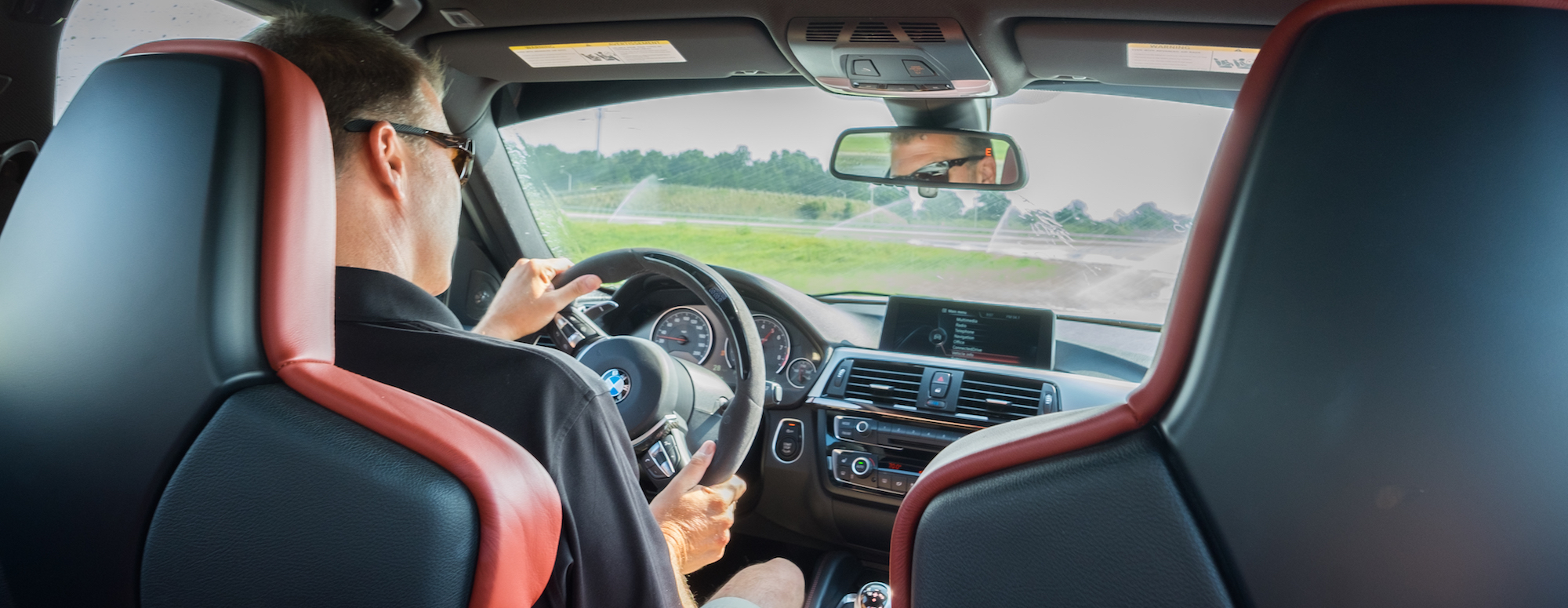BMW: A Day with the Ultimate Driving Machine
 There’s a green cone just off the edge of the track at the BMW Performance Center, marking where my first of four timed laps will start. I’m behind the wheel of a 135is, the fastest version of a diminutive vehicle affectionately known by German car enthusiasts as the “Baby Beemer.” Mine is the first in a line of five identical models—all in a color BMW calls “Deep Sea Blue Metallic”—set to take on the course, a partially wet, left-turning circuit with sets of cones forming corners and slaloms.
There’s a green cone just off the edge of the track at the BMW Performance Center, marking where my first of four timed laps will start. I’m behind the wheel of a 135is, the fastest version of a diminutive vehicle affectionately known by German car enthusiasts as the “Baby Beemer.” Mine is the first in a line of five identical models—all in a color BMW calls “Deep Sea Blue Metallic”—set to take on the course, a partially wet, left-turning circuit with sets of cones forming corners and slaloms.
As I pull the car slowly down to the start, a piece of advice from my group’s driving instructor, Andy pokes through the adrenalized blur: Watch out for that 90-degree turn where the pavement goes suddenly from wet to dry.
A few seconds later, my 320-horsepower pocket rocket shows me exactly what happens when the laws of physics run headlong into my need for speed. I spin out on that corner, rear wheels leave asphalt in favor of grass, and my first lap, an otherwise respectable run in the lower 30-second range, earns a disqualification.
The spin out is both hilarious and frustrating. I remembered to feather the throttle on that corner, right? And I’m at least half sure I know what “feathering the throttle” means. I meekly take my place at the back of the line to await my next lap, having served as a cautionary example for the other drivers. By the end of the run, I’ve managed to get my time down to 30.04 seconds, not bad for someone who hasn’t taken the class before, I’m told.
 It’s the exclamation point on what has been a day to remember at the BMW Performance Center on Highway 101 in Greer. Offering an array of programs teaching everything from basic car control for teens and adults to advanced techniques used by professional drivers, the Performance Center is the only one of its kind for BMW, which manufactures 300,000 cars annually at the $5 billion plant here. Visitors from all over the country make the trip each year to try their hand behind the wheel.
It’s the exclamation point on what has been a day to remember at the BMW Performance Center on Highway 101 in Greer. Offering an array of programs teaching everything from basic car control for teens and adults to advanced techniques used by professional drivers, the Performance Center is the only one of its kind for BMW, which manufactures 300,000 cars annually at the $5 billion plant here. Visitors from all over the country make the trip each year to try their hand behind the wheel.
Most classes offered are one-day or two-day experiences, and setting up your trip is as easy as visiting the center’s website, picking the class you want, and reserving your spot on the next available date the class is offered. Prices range from $550 for the one-day teen car control school, up to $3,595 for the advanced “M School” two-day courses.
My half-day class was a kind of sampler platter of the center’s offerings called the “Corporate Club,” a $400, large-group program that allows those curious about the Performance Center’s classes to get a taste of the track, and to get a feel for many of the different vehicles BMW makes. As such, my experience wasn’t all tire smoke and white knuckles. Some of it was off-road.
 Before my timed runs around the track, my group had taken a spin in the X3, the small crossover built across the street from the Performance Center at BMW’s massive manufacturing facility. We put the little SUV (BMW prefers to call the X3 a “Sports Activity Vehicle”) through its paces, driving through 20 inches of water and perching on two wheels at the top of a hill to demonstrate how rigid the frame is …or just to scare us into thinking the thing will flip over. Or both.
Before my timed runs around the track, my group had taken a spin in the X3, the small crossover built across the street from the Performance Center at BMW’s massive manufacturing facility. We put the little SUV (BMW prefers to call the X3 a “Sports Activity Vehicle”) through its paces, driving through 20 inches of water and perching on two wheels at the top of a hill to demonstrate how rigid the frame is …or just to scare us into thinking the thing will flip over. Or both.
Either way, the point lands solid. The BMW model most people associate with grocery stores and soccer practice is a very capable off-road machine, one the workers in Greer (7,500 of them) are rightly proud of.
It’s the same lesson over and over with every car I get the chance to drive. These machines are capable of so much more than what their typical owners demand of them, and it’s a little sad to think of such amazing examples of engineering as just road cars. In a very real sense, using a 560-horsepower M5 to as your daily commuter car would be like owning a grand piano and only learning to play “Chopsticks.”
Of course, most of us are used to “Chopsticks” driving; it’s comfortable and more importantly it’s legal, but the BMW Performance Center exists to take drivers out of their comfort zones. Here sharp corners are to be accelerated towards as quickly as nerves allow, with hard, controlled braking to happen just before—not during—the turn. Take the corner outside edge to inside edge. Accelerate. Repeat. It’s about as far removed from civilized driving as possible, except that in the same way learning a little Chopin will make you better at “Chopsticks,” learning to drive this way can make you better and safer on the road.
The idea is simple: learning what the vehicle you’re driving can do teaches you to have a much better understanding of what it cannot do. Stand on the brakes like a flock of baby geese just walked out in front of you, and the car calmly comes to a stop. Stomp the accelerator, and rather than wheel-spinning you into a white smoke-filled oblivion, the car’s traction control holds everything together. It’s a humbling thing to learn that a car knows more about driving than you do.
At the end of our day, we file back inside. Smiles adorn every face, and everyone has a highlight to share. We all get goodie bags with special hats and t-shirts that only people who’ve gone through a class get to take home. Our instructors claim that 30 percent of participants who make their way through one of the Performance Center’s classes will buy a BMW within three years, and frankly I’m surprised that number isn’t higher. All day in between times behind the wheel, I found myself doing the household budget in my head, crunching numbers to figure out how to make my next car one of these impressive machines.
 In the meantime, I’ve got a brochure for some of the more advanced driving classes strategically placed in a highly visible spot at home. I drew a big circle around the next class I’d like to take, because after all, my birthday is right around the corner.
In the meantime, I’ve got a brochure for some of the more advanced driving classes strategically placed in a highly visible spot at home. I drew a big circle around the next class I’d like to take, because after all, my birthday is right around the corner.
Christopher George, Produced in cooperation with the HubCity Writers Project.
 Christopher George is a freelance writer and Spartanburg native. He enjoys watching baseball and drinking too much coffee.
Christopher George is a freelance writer and Spartanburg native. He enjoys watching baseball and drinking too much coffee.






